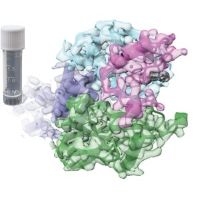Specification
| Description | Recombinant protein from the full-length sequence of Homo sapiens nuclear protein 1, transcriptional regulator (NUPR1), transcript variant 2 (NM_012385). |
| Organism | Homo sapiens (Human) |
| Expression Host | Human Cells |
| Tag Info | His or DYKDDDDK. Please contact us if you need further information or require specific designed tag. |
| Purity | Greater than 90% by SDS-PAGE gel |
| Uniprot ID | O60356 |
| Entry Name | NUPR1_HUMAN |
| Gene Names | NUPR1 COM1 |
| Alternative Gene Names | COM1 |
| Alternative Protein Names | Nuclear protein 1 (Candidate of metastasis 1) (Protein p8) |
| Application | Antigens, Western, ELISA and other in vitro binding or in vivo functional assays, and protein-protein interaction studies; For research & development use only! |
| Buffer | Purified protein formulated in a sterile solution of PBS buffer, pH7.2, without any preservatives |
| Endotoxin | Endotoxin level is < 0.1 ng/µg of protein (<1EU /µg) |
| Length | 82 |
| Molecular Weight(Da) | 8873 |
| Protein Sequence | (The sequence of expressed protein may have some variation from the sequence shown below. Please contact us for the exact sequence.) MATFPPATSAPQQPPGPEDEDSSLDESDLYSLAHSYLGGGGRKGRTKREAAANTNRPSPGGHERKLVTKLQNSERKKRGARR |
Background
| Function | FUNCTION: Transcription regulator that converts stress signals into a program of gene expression that empowers cells with resistance to the stress induced by a change in their microenvironment. Thereby participates in regulation of many process namely cell-cycle, apoptosis, autophagy and DNA repair responses (PubMed:16478804, PubMed:19650074, PubMed:16300740, PubMed:19723804, PubMed:11056169, PubMed:22858377, PubMed:11940591, PubMed:18690848, PubMed:22565310, PubMed:20181828, PubMed:30451898). Controls cell cycle progression and protects cells from genotoxic stress induced by doxorubicin through the complex formation with TP53 and EP300 that binds CDKN1A promoter leading to transcriptional induction of CDKN1A (PubMed:18690848). Protects pancreatic cancer cells from stress-induced cell death by binding the RELB promoter and activating its transcription, leading to IER3 transactivation (PubMed:22565310). Negatively regulates apoptosis through interaction with PTMA (PubMed:16478804). Inhibits autophagy-induced apoptosis in cardiac cells through FOXO3 interaction, inducing cytoplasmic translocation of FOXO3 thereby preventing the FOXO3 association with the pro-autophagic BNIP3 promoter (PubMed:20181828). Inhibits cell growth and facilitates programmed cell death by apoptosis after adriamycin-induced DNA damage through transactivation of TP53 (By similarity). Regulates methamphetamine-induced apoptosis and autophagy through DDIT3-mediated endoplasmic reticulum stress pathway (By similarity). Participates in DNA repair following gamma-irradiation by facilitating DNA access of the transcription machinery through interaction with MSL1 leading to inhibition of histone H4' Lys-16' acetylation (H4K16ac) (PubMed:19650074). Coactivator of PAX2 transcription factor activity, both by recruiting EP300 to increase PAX2 transcription factor activity and by binding PAXIP1 to suppress PAXIP1-induced inhibition on PAX2 (PubMed:11940591). Positively regulates cell cycle progression through interaction with COPS5 inducing cytoplasmic translocation of CDKN1B leading to the CDKN1B degradation (PubMed:16300740). Coordinates, through its interaction with EP300, the assiociation of MYOD1, EP300 and DDX5 to the MYOG promoter, leading to inhibition of cell-cycle progression and myogenic differentiation promotion (PubMed:19723804). Negatively regulates beta cell proliferation via inhibition of cell-cycle regulatory genes expression through the suppression of their promoter activities (By similarity). Also required for LHB expression and ovarian maturation (By similarity). Exacerbates CNS inflammation and demyelination upon cuprizone treatment (By similarity). {ECO:0000250|UniProtKB:O54842, ECO:0000250|UniProtKB:Q9WTK0, ECO:0000269|PubMed:11056169, ECO:0000269|PubMed:11940591, ECO:0000269|PubMed:16300740, ECO:0000269|PubMed:16478804, ECO:0000269|PubMed:18690848, ECO:0000269|PubMed:19650074, ECO:0000269|PubMed:19723804, ECO:0000269|PubMed:20181828, ECO:0000269|PubMed:22565310, ECO:0000269|PubMed:22858377, ECO:0000269|PubMed:30451898}. |
| Pathway | |
| Protein Families | NUPR family |
| Tissue Specificity | Widely expressed, with high levels in liver, pancreas, prostate, ovary, colon, thyroid, spinal cord, trachea and adrenal gland, moderate levels in heart, placenta, lung, skeletal muscle, kidney, testis, small intestine, stomach and lymph node, and low levels in brain, spleen, thymus and bone marrow. Not detected in peripheral blood leukocytes. {ECO:0000269|PubMed:10092851}. |
QC Data
| Note | Please contact us for QC Data |
| Product Image (Reference Only) |  |

